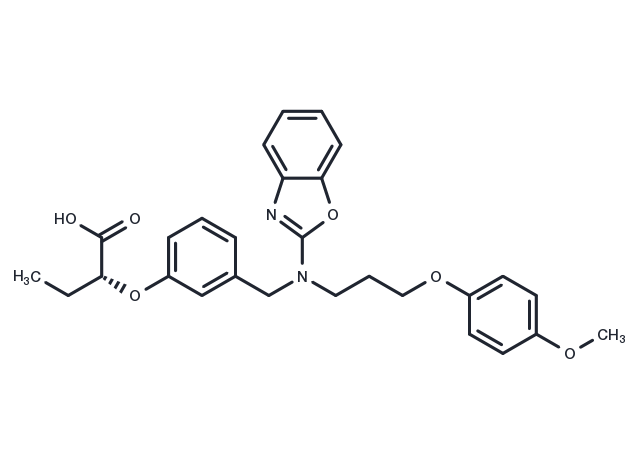Powder: -20°C for 3 years | In solvent: -80°C for 1 year


Pemafibrate ((R)-K-13675) is a highly specific PPARα agonist (EC50: 1 nM).

| Pack Size | Availability | Price/USD | Quantity |
|---|---|---|---|
| 1 mg | In stock | $ 51.00 | |
| 5 mg | In stock | $ 123.00 | |
| 10 mg | In stock | $ 189.00 | |
| 25 mg | In stock | $ 369.00 | |
| 50 mg | In stock | $ 542.00 | |
| 100 mg | In stock | $ 773.00 | |
| 1 mL * 10 mM (in DMSO) | In stock | $ 143.00 |


| Description | Pemafibrate ((R)-K-13675) is a highly specific PPARα agonist (EC50: 1 nM). |
| Targets&IC50 | PPARγ (human):1.1 μM (EC50), PPARα (human):1 nM (EC50) |
| In vitro | Pemafibrate is a potent PPARα agonist, with EC50s of 1 nM, 1.10 μM and 1.58 μM for h-PPARα, h-PPARγ, and h-PPARδ, respectively. |
| In vivo | Pemafibrate (3 mg/kg, p.o.) increases plasma h-apoA-I in human apoA-I (h-apoA-I) transgenic mice, and shows higher levels of plasma h-apoA-I than fenofibrate at 300 mg/kg [1]. Pemafibrate (0.03?mg/kg) decreases levels of triglycerides and aspartate aminotransferase (AST) in PEMA-L (db/db) mice. Pemafibrate (0.1?mg/kg) not only shows such effects but increases liver weight in PEMA-H (db/db) mice. Pemafibrate enhances the pathogenesis in a rodent model of nonalcoholic steatohepatitis (NASH). Pemafibrate significantly reduces the grade of hepatocyte ballooning in PEMA-H mice [2]. Pemafibrate (K-877, 0.0005%) contained in a high-fat diet (HFD) inhibits the body weight gain in mice. Pemafibrate significantly decreases the abundance of triglyceride (TG)-rich lipoproteins, including remnants, in postprandial plasma of mice. Pemafibrate also decreases intestinal mRNA expression of ApoB and Npc1l1 [3]. |
| Animal Research | Mice are fasted for 12?h and fasting blood glucose measured. Nine-week-old db/db mice are used in the assay. After a 2-week acclimatization period, mice are divided into four groups: BD (db/db) mice (fed basal diet (BD) and treated with 0.5% aqueous methylcellulose solution (MC); MCD (db/db) mice (fed methionine choline-deficient (MCD) and treated with 0.5% MC); PEMA-L (db/db) mice (fed MCD and treated with 0.03?mg/kg Pemafibrate); PEMA-H (db/db) mice (fed MCD and treated with 0.1?mg/kg Pemafibrate). The drug-free solvent or the dosing solution is administered to animals (5?mL/kg body weight, p.o.) once daily (in the morning) for 4 consecutive weeks. After a 2-week acclimatization period, BD mice are fed a BD for 20 weeks. CTRL mice are fed D09100301 for 20 weeks. PEMA-L and PEMA-H mice are fed D09100301 for 12 weeks followed by D09100301 with 0.4?mg and 1.3?mg Pemafibrate/kg of the diet for 8 weeks, which corresponds to 0.03?mg/kg/day and 0.1?mg/kg/day, respectively. FENO mice are fed D09100301 for 12 weeks followed by D09100301 with 666.7?mg fenofibrate/kg of the diet for 8 weeks, which corresponds to 50?mg/kg/day. Pemafibrate and fenofibrate are incorporated into the AMLN diet. Animals are housed under conventional conditions with controlled temperature, humidity, and light (12-h light-dark cycle) and provided with food and water [2]. |
| Synonyms | (R)-K-13675 |
| Molecular Weight | 490.55 |
| Formula | C28H30N2O6 |
| CAS No. | 848259-27-8 |
Powder: -20°C for 3 years | In solvent: -80°C for 1 year
H2O: Insoluble
DMSO: 100 mg/mL (203.85 mM)
You can also refer to dose conversion for different animals. More
bottom
Please see Inhibitor Handling Instructions for more frequently ask questions. Topics include: how to prepare stock solutions, how to store products, and cautions on cell-based assays & animal experiments, etc.
Pemafibrate 848259-27-8 DNA Damage/DNA Repair Metabolism PPAR K13675 K 13675 K-13675 (R)-K-13675 inhibitor inhibit
